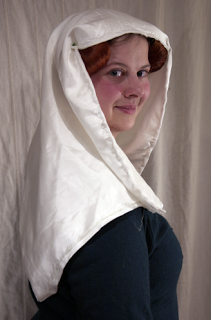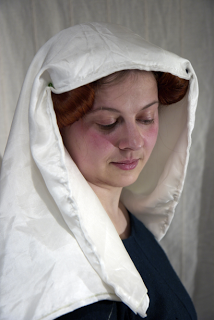Now as promised, the problems I have with this version.
First of all, the kruseler. It consists of multiple layers (I think eight layers) of fine silk fabric, woven in tabby. It's the thin quality you can buy for painting scarves, Pongé 05. The "ruflles" consists of the selvedges of the fabric. All cut edges are sealed with beeswax.
The ruffle, to me, does not look voluminous enough. This might be due to not enough layers, or it could be possible to seal/impregnate the edges in the ruffle with (bleached) beeswax and form it, still warm, into the characteristic wavy form. The next one will be better, I hope.
Then, the hairdo. I am pretty content with how it looks on the photos (though the right "horn" has uncoiled slightly), and it is actually comfortable to wear once it is arranged symmetrically and fixed securely. And that is the snag. I find it enormously difficult to do the two lumps of hair, both securely, both similarly tight and starting from the right spot. Then these two horns have to be pinned to the head. I have a lot of experience nowadays with the simple, u-shaped pins that have been used in the middle ages (and are still available today, thanks to the powers that be), but while the first one is always more or less agreeable, the second horn invariably droops. Or wanders. Or uncoils, if it is really cross.
So while putting up the hair in this way is technically no problem for me - the motions for making the horns are easy, and the single-roll-on-back-of-the-head version of the updo is one of my staples (and I wear my hair up all days, all the time, with only a handful of exceptions a year) - it is still a problem to get it symmetrical, and both twin horns secured firmly. That is probably something to come with practice, but the updo without the veil looks pretty... hmm... let us settle for weird, and the same is true for modern eyes when worn with the veil. And that is the reason why I am not running around with this updo every day. (Plus it won't fit under a bicycle helmet.)
And last of all problems, the pinning. Kruselers worn on the pictures are shown either with a rounded look or with an angular look (the one I'm aiming for). While both can be achieved with changing the hairdo, I haven't yet found any pins shown on the kruseler paintings. Some way of holding the veil to the head must have been used, and I'll assume it was not hot glue straight out of the glue gun. So the big question is: Where and how was the veil fixed (pinned, probably) to the hair? Or was there some other solution? I have had lots of problems, and I always need several tries, to find the right place and right angle for the (bronze) pins to really hold the veil, and for more than some seconds. And it's not only holding it down: the veil should cover the hairline on the forehead, show some of the hair bump beneath and then fall down in a nice, straight line.
I'll happily try out suggestions the next time I wear this, so please shoot!
First of all, the kruseler. It consists of multiple layers (I think eight layers) of fine silk fabric, woven in tabby. It's the thin quality you can buy for painting scarves, Pongé 05. The "ruflles" consists of the selvedges of the fabric. All cut edges are sealed with beeswax.
The ruffle, to me, does not look voluminous enough. This might be due to not enough layers, or it could be possible to seal/impregnate the edges in the ruffle with (bleached) beeswax and form it, still warm, into the characteristic wavy form. The next one will be better, I hope.
Then, the hairdo. I am pretty content with how it looks on the photos (though the right "horn" has uncoiled slightly), and it is actually comfortable to wear once it is arranged symmetrically and fixed securely. And that is the snag. I find it enormously difficult to do the two lumps of hair, both securely, both similarly tight and starting from the right spot. Then these two horns have to be pinned to the head. I have a lot of experience nowadays with the simple, u-shaped pins that have been used in the middle ages (and are still available today, thanks to the powers that be), but while the first one is always more or less agreeable, the second horn invariably droops. Or wanders. Or uncoils, if it is really cross.
So while putting up the hair in this way is technically no problem for me - the motions for making the horns are easy, and the single-roll-on-back-of-the-head version of the updo is one of my staples (and I wear my hair up all days, all the time, with only a handful of exceptions a year) - it is still a problem to get it symmetrical, and both twin horns secured firmly. That is probably something to come with practice, but the updo without the veil looks pretty... hmm... let us settle for weird, and the same is true for modern eyes when worn with the veil. And that is the reason why I am not running around with this updo every day. (Plus it won't fit under a bicycle helmet.)
And last of all problems, the pinning. Kruselers worn on the pictures are shown either with a rounded look or with an angular look (the one I'm aiming for). While both can be achieved with changing the hairdo, I haven't yet found any pins shown on the kruseler paintings. Some way of holding the veil to the head must have been used, and I'll assume it was not hot glue straight out of the glue gun. So the big question is: Where and how was the veil fixed (pinned, probably) to the hair? Or was there some other solution? I have had lots of problems, and I always need several tries, to find the right place and right angle for the (bronze) pins to really hold the veil, and for more than some seconds. And it's not only holding it down: the veil should cover the hairline on the forehead, show some of the hair bump beneath and then fall down in a nice, straight line.
I'll happily try out suggestions the next time I wear this, so please shoot!






